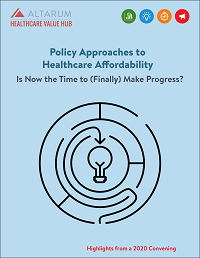Policy Approaches to Healthcare Affordability: Is Now the Time to (Finally) Make Progress?
The Healthcare Value Hub’s healthcare affordability mini-conference, "Policy Approaches to Healthcare Affordability: Is Now the Time to (Finally) Make Progress," was held at the National Press Club in Washington, D.C. on February 12, 2020. This event featured policy experts who identified a broad spectrum of state and national policy recommendations designed to make healthcare more affordable. Panelists discussed the flurry of new reports and governmental activities—suggesting that we may begin to see progress on healthcare affordability—but expressed concern that current efforts are insufficient. Ample opportunities for audience participation allowed attendees to discuss additional policy options that states can adopt to address healthcare costs.
Conference Sessions
Panel 1: State and Federal Affordability Policies
In the first discussion, panelists were asked a series of questions regarding healthcare affordability policies at the state and federal levels. Moderator Joanne Kenen, Executive Editor at Politico, noted a general lack of understanding of the difference between healthcare spending and affordability.
In response to Kenen’s opening, Jen Mishory, Senior Fellow at The Century Foundation, described the foundation’s recent publication that examines federal options to address the “premium affordability gap,” including: coverage subsidies (such as Medicare for All, Medicaid buy-in and building on Affordable Care Act subsidies), lowering industry profit margins and tying provider payments to Medicare or Medicaid rates.
Lynn Quincy, Director of the Healthcare Value Hub, explained a four-part framework to address healthcare affordability. Referencing the Hub’s Healthcare Affordability State Policy Scorecard, Quincy identified four key areas in which states should focus:
- Extending affordable, quality coverage to all residents;
- Making cost-sharing affordable and evidence-based;
- Reducing the provision of low- and no-value care; and
- Curbing excess healthcare prices.
Quincy suggested that states choose one area to focus their initial efforts but clarified that they don’t have to all start in the same place. The appropriate starting point will depend on states’ unique challenges and policy environments.
Our third panelist, Roslyn Murray, consultant for Catalyst for Payment Reform, provided a deep dive into the role of unit prices in driving up healthcare costs for state residents. Murray identified state strategies to address high prices that result from provider consolidation, in particular, referencing a new report from the Urban Institute. She noted that an important solution–not yet widely used–is to regulate prices in highly consolidated markets. Such markets lack competitive forces to rein in prices.
All panelists provided additional examples of state affordability policies, including:
- Insurance commissioners’ ability to reject proposed health insurance premiums deemed “unaffordable” in Colorado and Rhode Island;
- Price ceilings in Oregon and Montana’s state employee benefit contracts; and
- Colorado’s latest effort to offer a public option that limits hospital prices.
Panel 2: Affordability Standards to Measure Success
Our second panel discussed current efforts to measure healthcare affordability, which is vital to realizing state and federal policy goals. Panelists noted that, while imperfect, existing standards such as the Federal Poverty Level help craft actionable policies and provide a benchmark to measure policies’ effectiveness.
Liz Hagan, Senior Policy Manager for U.S. of Care, discussed state efforts to standardize healthcare affordability. Hagan noted that there is more than one way to measure healthcare affordability, but not all ways are created equal. She noted that judging affordability based on just premiums is simply not enough, and we must find more evidence-based policies to address healthcare affordability at the state level.
During the panel, Janet Weiner, Co-Director for Health Policy at the Leonard Davis Institute of Health Economics (LDI), explained that the tax-exclusion for employer-provided coverage causes low income workers to pay significantly more for the same coverage, compared to higher income employees. Weiner affirmed that affordability standards cannot ignore cost-sharing and advocated for a cost-sharing cap or subsidies for cost sharing in lieu of a tax break. Additional ideas that she shared are published in LDI’s brief on affordability concepts.
Our third panelist, Vicki Veltri, Executive Director of Connecticut’s Office of Health Strategy, described her office’s comprehensive approach to looking at healthcare affordability in the context of real life. Connecticut’s effort to create an affordability standard reflects the many factors that determine a family’s ability to afford healthcare—not only income but family size, non-healthcare related financial obligations and health status.
In the end, speakers listed next steps that states can take to address affordability, such as Medicaid expansion, legislation to address surprise medical bills, decreasing use of low-value care and establishing state-level all-payer claims databases to provide the necessary data to measure success. All panelists agreed that educating state policymakers is crucial to making progress.
Closing & Reflections
The event concluded with moderator Joanne Kenen sharing her thoughts on the topic, guided by Andrea Ducas, Senior Program Officer at the Robert Wood Johnson Foundation. Kenen reiterated comments made by panelists throughout the event and noted that we should be dealing with healthcare affordability issues at both the state and federal level. She called on audience members to lift up the voices of consumers as we continue to fight for their protections.
More information and a recording of the convening can be found on our event page.







